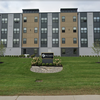After hubbub, Phillips puts hardware sign request on hold as he seeks variance for minimart sign
GUILDERLAND — A number of immediate area residents are against Phillips Hardware’s attempt to place advertisements on the outside of its building.
In January, Jonathan Phillips, who owns the store on the outskirts of Altamont, sought an area variance from the town law that allows two signs with an area not to exceed 50 square feet — he was looking for four signs that would total 128 square feet in area.
That request met with unanimous pushback from Guilderland’s zoning board, which led Phillips to come back before the board earlier this month with a request for two signs that covered half the square footage, to which the board was more receptive. But, at the Feb. 16 meeting, Phillips requested a postponement.
Had Phillips had windows on the front of the building the entire ordeal would have been moot because town law would have allowed the store to hang the signs on the interior of space, but windows were done away with as a cost-saving measure during construction, according to Phillips, president of Phillips Hardware.
Phillips told The Enterprise this week that he’s putting his hardware store signs on the back burner while he tackles his next zoning board request: area variances for the signs he wants to place at the corner of routes 146 and 158.
Phillips’s application for a Mobil, Dunkin Donuts, and an eponymous minimart sign were before the Albany County Planning Board on Feb. 17 — the board determined granting the variances would have no county-wide impact and deferred to Guilderland on the decision. The next town’s zoning board meeting is scheduled for March 2.
Jan. 5 meeting
Tom Wheeler of AJ Sign said the building housing the store looks like a warehouse, and with the proposed signs Phillips is looking to identify some of the “key” brands — or “destination brands” — that will attract customers to the store.
Stihl, Carhartt, and Benjamin Moore are “brands that not everybody has [but] that Phillips Hardware is lucky enough to have,” Wheeler said. The fourth sign would have advertised Phillips Hardware itself.
The signs Phillips now wants to put on his store highlight Stihl, which intentionally doesn’t sell its chainsaws and other handheld power equipment at the nation’s largest big-box hardware stores, and Benjamin Moore paints, from which Phillips told The Enterprise he’d recently received a letter “about exclusivity,” and Benjamin Moore paints aren’t sold in Lowe’s or Home Depot either.
“The signs [of the products] I want to put on my store are nationally known as independent brands that help you compete against box stores,” Phillips said.
Phillips said he’s not looking to negatively impact the neighborhood and community with his proposal; rather, he’s “looking to be able to pay taxes and make sure I have enough traffic to keep people employed and keep that project above ground, and signs help draw traffic.”
Zoning board Chairman Thomas Remmert during the Jan. 5 meeting read the part of the town code related to signs, the purpose of which is to “control the quality and quantity of signs so as to enhance the identification of business and professional enterprises and improve the visual quality of the community.” What Phillips is looking for with his request, Remmert said, is strictly advertising signs.
Remmert noted that emails in opposition to the application pointed out granting the request would create a precedent for other businesses in the area seeking variances.
Five criteria have to be met for a variance, Remmert said; the Phillips request failed on two of the five: it was a self-created problem and it was a substantial request.
Phillips told the board he’s at a disadvantage because he doesn’t benefit from the density that other businesses in the area have, like those on Western Avenue, Central Avenue, and Washington Avenue Extension.
“I’m on an island by myself,” he said.
Phillips, who has a forceful personality and is active in community and charitable endeavors, said he wasn’t trying to “leverage the support I’ve had in the community to come to the board and go, ‘This is what I want because we want it.’”
Remmert said Western Avenue is a completely different situation; it’s a highly-commercial corridor — and even along Western Avenue itself there are degrees of variations. The signs in Westmere, the heart of the commercial corridor, are different from the signs in McKownville, an older residential neighborhood, Remmert said.
Board member Sharon Cupoli made the point that Phillips Hardware has been a long-established business on the corner of routes 146 and 158, so people know it’s there. And they know he doesn’t just sell “nuts and bolts; he sells a whole line of things,” because the store has done so for “years and years and years.”
Board member Elizabeth Lott said it sounded like what Phillips had was a marketing dilemma and helping a business with its marketing was beyond the zoning board’s purview.
What the board does with Phillips Hardware will set the precedent for the area, Remmert said; if it grants 180-square-feet of signs for the hardware store, then Dunkin’ Donuts and Mobil Gas will want the same.
Remmert said he wanted to hear what people who actually lived around the hardware store thought about the proposal. “The best way we tell how a neighborhood is affected is by hearing from the neighbors,” he said. Phillips posited that the lack of neighbor pushback was an indication of area acceptance.
Feb. 2 meeting
On Feb. 2, Phillips submitted a revised application for two signs totaling 64 square feet of backlit signs.
Also submitted for the meeting were petitions in favor and against the proposed signs. A petition from Phillips himself had 278 signatures and included letters of support from the Guilderland Chamber of Commerce, the Capital Region Chamber, and the Capital Development Corporation.
The other petition, opposing the variance, had 14 signatures from residents who live in the immediate vicinity of Phillips Hardware and write “as the neighbors who will be most impacted by the incompatibility to the character of our cherished environs, we feel that our opinions should have prominence.”
Karen White called into the meeting and pointed out that the petition signed by 14 residents were all close-by neighbors. “Every time there’s an issue that comes up before the ZBA, you folks always say that it’s the neighbors who really have a say; they have standing in these issues,” White said.
She said Phillps had “stuck a petition at his register and just asked people to sign it,” many of whom were not local residents. Phillips took exception to White’s characterization of how he garnered that public support for his application. He felt his credibility was being questioned for “improperly communicating the petition,” and told The Enterprise, “I become defensive when people attack my character.”
The first page of the petition submitted to the zoning board included the following: “Phillips Hardware is seeking approval to have their large brands shown on front exterior wall. One sign is Benjamin Moore and the other sign is split between Carhartt and Stihl. These our [sic] large departments that when known to Neighbors can result to increase traffic at a location. If you are interested in support of these signs please add your name to the petition on the next page with your address…”
There were at least 90 signatures on Phillips’ submitted petition that were associated with an Altamont address — which is the official name of the 12009 ZIP code, and stretches for 52 miles over the western half of Guilderland, all of the village of Altamont, and a chunk of Knox, and has a population around 8,000.
Gerhard Beckmann, who signed the petition against the variance and lives at 590 Route 146, said he has standing and he can see the lights of the building, which he said are on all night.
Phillips acknowledged to The Enterprise what’s been said about his proposal over the past couple of months — “Some neighbors say, ‘You know, the light coming from the signs” — but he pushed back on some of that criticism, saying, “Anyone who knows my property, [knows] there’s not really any neighbors right across the street from me, [and] those signs are going to be under an overhang.”
Phillips chafed at what he sees as a vocal minority.
“These are the same people that come out against everything,” he said of the members of the Guilderland Coalition For Responsible Growth, although he also admitted “I didn’t expect as much noise.” But he now realizes he’s going to have to have people who are in favor of his future proposals call in to support them because otherwise it always “sounds just negative.”
Board member Jake Crawford, who had driven by the site at night, disagreed with Beckmann’s characterization and said the new store hadn’t been lit up any more than the previous Phillips Hardware store. Crawford was the only board member who hadn’t tipped his hand about how he intended to vote on the variance.
When asked this week if he would vote to approve or deny the request, he said, “Let me be as honest as I can: I had no idea how I was going to vote until I listened to the motion put forward by Chairman Remmert.”
Remmert could have offered a motion to approve Phillips’ application as of Feb. 2, Crawford said, or he could have put forth a motion to deny any increase in signage, so it wasn’t until he heard the motion that he could have his “mind decided which way I was going to vote.” Crawford said he thought there might have been a way to tailor a motion that allowed for some increase in signage, but nothing like what was initially put forward by Phillips.
Remmert struck a different tone on Feb. 2.
He said the canopy on the building had “reduce[d] the effect” of the proposed signs somewhat, and said there really aren’t any residences within view of the proposed sign — a mitigating factor, in his view.
Remmert said he was leaning toward approving the variance but, when he asked if he should make the motion to approve Phillips’ request, it was met with silence and awkward smiles, until Richard Villa said Phillips had made a good-faith effort to minimize the size of the variance and said he wouldn’t be against granting the variance.
Lott said she was opposed to granting the variance because the sign was advertising and not a sign for Phillips Hardware itself. Cupoli said she was against the variance and pointed to a letter that noted Phillips’s website didn’t highlight the brands he’s looking to have signs for.
In the end, Phillips asked for the matter to be shelved.



